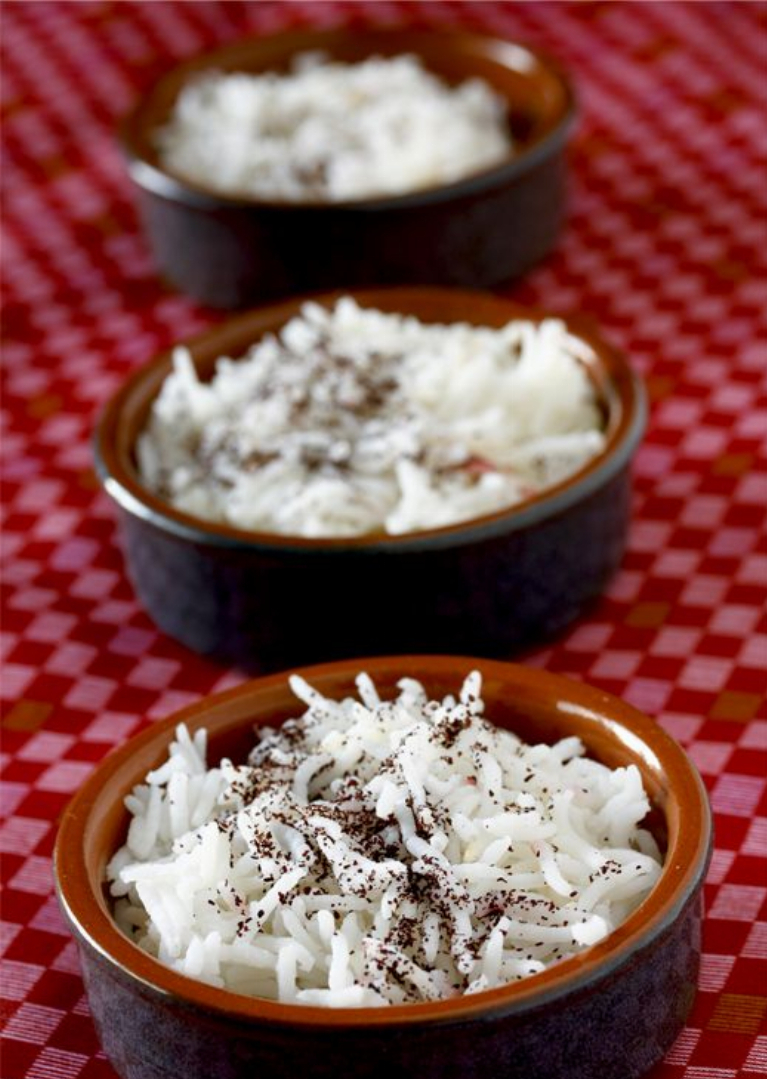Ah, basmati rice. I don’t think there is a food that better represents the similarities and differences of Indian Subcontinent and East Asian cultures. Rice is the staple starch in both of these Asian regions, but the preparation couldn’t be more different. In the Far East, sticky jasmine rice is typically prepared with every meal. Chopsticks are the utensil of choice, which helps explain the popularity of rice that can stay clumped together on the journey from the bowl to the mouth.
By contrast, the quality of cooked basmati rice is judged primarily by how separate the grains remain. Traditionally, people of the subcontinent eat with their hands, and the various dals and kormas do a great job of creating cohesion.
Preparing basmati rice at home is not nearly as challenging as it may seem, but as is the case with many simple dishes, precision and care are required. Like pasta, if it’s cooked past ”al dente”, basmati rice will become mushy.
I didn’t have much experience with basmati rice until I got married. After more than five years, I have not only learned how to make it, I have come to love it. In our home, we make both sticky Asian jasmine rice and Indian basmati rice everyday to satisfy the different palates. We typically eat it with dal, but the girls love to have basmati rice with a little butter and sumac. Sumac is a common Middle Eastern spice and has a deep reddish, purple color. You can see it sprinkled over the rice in the photos.
If you don’t have well cooked basmati rice on a regular basis, you don’t know what you’re missing. I know that for a long time I didn’t!
1. Info for How to Cook Basmati Rice
- Cook Time: 30 min
- Total Time: 45 min
- Servings: 10
- Calories: 274 kcal
2. Ingredients for How to Cook Basmati Rice
- 4 cups white basmati rice
- 3 cloves
- 5 cardamom pods
- 1 black cardamom pod
- juice of half a lemon
- 2-½ teaspoons salt
- 4 tablespoons ghee (or regular butter), as needed
- 3 tablespoons sumac (optional), as needed
3. Directions:
- Wash and rinse the rice thoroughly in several water baths (about three times). Place in a large bowl, cover with water. Add the juice of half a lemon with its pulp. Soak for at least 10-15 minutes. Drain as much water as possible.
- Fill a large pot with about 4 quarts of water. Add the spices. Bring to a boil. Add the rice. Bring the liquid back to a boil, then immediately lower the heat to a gentle boil. That way the rice will cook evenly all the way through evenly. Cook for about 7-8 minutes at a bubbly simmer. Add 1 teaspoon of salt half-way through the cooking process (it will enhance the natural flavor of the rice and it will be more tender). Keep stirring the rice every now and then so that it doesn’t stick to the bottom of the pot. It may take longer than the cooking time written in the instructions on the package. The grains of rice should still be a little hard, about 2/3 of the way cooked. Check often and do NOT wait until the grains are soft (see tips). Drain the liquid from the rice using a fine mesh colander. Do NOT rinse. Discard the liquid.
- Transfer the rice to a smaller pot. Using the pestle (the stick) of a mortar and pestle, create 3 evenly-spaced holes (forming a triangle) in the pot of rice and drizzle about ½ to 3/4 cup of water into the rice. Place little mounts of ghee all over the pot. Sprinkle with 2 tablespoons of sumac (if used). Seal the pot with an aluminum sheet and cover the pot. Place on the stove over high heat for about 3-4 minutes. Steam should escape from the pot. Turn off the heat and wait at least 10 minutes for the rice to set. Do not remove the lid.
- Some grains of rice will turn purple (almost the same color as beets). Gently fluff the rice using long chopsticks (or a fork) without breaking the grains of rice. The rice is ready.
- Sprinkle with more sumac.
- Bon appétit!

